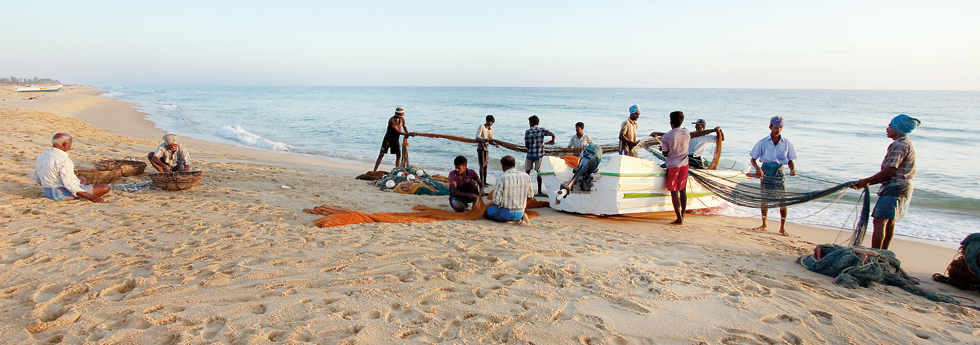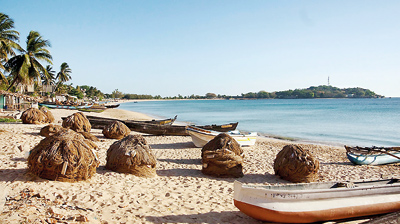View(s):
Those of my vintage and earlier remember Vakarai with nostalgia. This was in an era now long gone. Many, including planters, used to go to places like Arugam Bay, Naltrexone buy usa Passikudah, Panichankerni, Vakarai and Verugal, all of which are on the East coast, for rest and relaxation and to also indulge in shooting, fishing and sea bathing. Wild and undeveloped, these places offered a totally different environment and atmosphere in which to relax. Shooting pig and jungle fowl was for fun and the spoils were for the pot. Excess wild boar flesh was given to the trackers and the villagers who lived in those areas.

To reach Vakarai you had to cross a ferry at Panichankerni. Now there is a brand new bridge that was opened recently. On the other side of the ferry was a two bed-roomed Rest House and visitors generally booked the entire Rest House. The Rest House Keeper at Vakarai was, in the manner of many of his kind all over the island, a great cook and good at general hospitality. Some Rest House keepers were great raconteurs sometimes drawing the long bow. This Rest House is now no more having gone in the tsunami.
I have a small beach house in Panditivu, North Vakarai and these observations on the fishing in the sea in front of my place and along the beach were made from many visits to Vakarai.
The bay is one of the many bays between Batticaloa and Trincomalee called Panditivu which is the name of a small island close to the shore, so called because long ago it is supposed to have been covered in thick jungle and many wild pigs lived there. North of Panditivu is Murukkantivu and south, in another bay, is Kandalady, Sallithivu or Panichankerni. The southern part of the Vakarai bay and the northern part of the Kandalady bay have been left for the fishermen using throw nets. No other type of fishing is allowed.
There are many ways in which fish are caught in different parts of Sri Lanka. Fishing is carried out in fresh water, brackish water and in the sea. Fish are caught for sport, subsistence and for commercial purposes. There is fishing that is done with rod and reel, both from the land or standing in the water or by boat. Fish are caught with a net both from a boat or whilst standing in the water. Trolling, which is trailing a hook or hooks from a moving boat, is another type of fishing. This is done mainly in the sea. The men on wooden stilts fixed in the sea catch a particular species of fish. The last is where a large net is laid in the sea and hauled in by a group of men standing on the shore.
Many of those living along the coast and on the borders of the large Vakarai lagoon earn their living by fishing. The prawns and fish in the lagoon are caught by the people of the area while those living along the coast in Vakarai are employed by the big businessmen who use drag nets or Ma Del to catch fish. Some of these are local businessmen and many others come from the west coast when the south-west monsoon is on and fishing there is impossible.
There are three types of fishing practised here. One is where two people go in a boat in the shallow seas, lay a net and catch the fish that they drive into the net. Another method is where about five boats fish as a group. In both these methods there are only two men in each boat. The fishermen go out into the deep sea and after laying the net, bring them closer and closer to each other, trapping the fish in the net. After the fish are collected in their boats, the process is continued. Most of those who fish by boat here are from Ottamavadi, a town adjoining Valaichenai.
The third method of fishing is with the use of a Madela. Madel fishing is said to be the oldest method of fishing in Sri Lanka. In this method, in operation on the beach in Vakarai and other beaches, a boat goes spreading the net in a systematic manner. Aniamanda is the part of the net that is on the left hand looking out to sea. This is loaded first onto the boat. Then the middle part of the net called Madiya is loaded and finally the Avaramanda which is the right hand side.
The boat then leaves the shore, dropping the net as it goes along. The first part of the net to be dropped is the Avaramanda then, at the apex of the net, which is a semi circle, the Madiya is laid. Then the boat returns to shore whilst dropping the Aniamanda. There are stones or bricks, about two kilos in weight, tied about ten feet apart, right along the bottom of the net. This is to make sure that one part of the net sinks. The top end of the net has small buoys to help keep it afloat. The two ends of the net have a strong rope about forty feet long. This is for the two gangs of men to start dragging in the net.
When drawing the net, the men holding the rope are positioned about ten feet apart, one behind the other. They draw the net in one motion. Then whilst dragging the rope the last man coils the rope they have drawn so far and comes to the front of the line and so the process of dragging the net goes on. The drawn rope is piled up carefully for use the next time. When the process of drawing the net starts the two rows of men are about 50 to 60 feet apart. Little by little the two rows move towards each other and finally are together when the net comes ashore.
The Department of Fisheries gives out for a fee, parts of the beaches for fish mudalalis to engage in Madel fishing. This is on an annual contract. They are the only people who can catch fish in the sea within the demarcated lines. Most times the a??franchise holdera?? leases out his franchise to another person to catch fish there.
At least 15 men are needed on each side to drag the net back. It is easier if there are more men in the line. The Ma dela is thrown out and dragged in twice a day. The whole process takes close to two hours. Some times when there is plenty of fish, the net is thrown a third time. Each person is paid Rs.500 per day for drawing the net twice or Rs. 600 if the net is dragged three times. The group operating on the Vakarai beach have brought 15 men from Chilaw to help in the operation, since they cannot depend on the locals to come for work consistently.
The experienced man in charge of the whole operation, called Man Rala has a thorough knowledge of the entire operation.
Anthony Fernando of Chilaw, who is the Man Rala on the Vakarai beach, said that one of the main problems that they now face is the reduction in the number of fish in the waters that they operate in. Most of the fish live and breed in and around the rocks in the sea.
Illegal dynamiting kills not only the big fish but the fingerlings as well. The eggs too are destroyed. The dead fish are all collected in a small net, about 1/2a?? or 1a?? in size. As a result a reduced number of fish are able to grow to maturity. Their complaints to the authorities and the law enforcement agencies have fallen on deaf ears.
What a catch!
Fish caught off the shores of Vakarai (Sinhala name first);
Salayas, (E) Gold Striped Sardinella (Sardinella gibbosa ) and Sudayas, (E) White Sardinella (Sardiunella Albella).
These two species look alike and are about the same size. However the Sudaya is flat and the Salaya is fattish and round. The Salaya gets caught in the Ma Dela but the Sudaya is caught in calm waters when a special net is fixed to the Ma Dela.
Kumbalawa- (E) Indian Mackerel (Rastrelliger kanagurta) is caught if they come within the Ma Dela range. On my recent visit, even though the seas were fairly rough, the fisherman were out in their boats at night catching Kumbalawas.A?Ata Nagul Paraw -(E) Jack (Caramx ignobilis) comes periodically in shoals. Their tails are yellow and the rest of the body also has yellow. These fish live in the rocks below sea level. Once in they cannot get out of the Ma Dela
Gineti Paraw -(E) Yellowa??tailed Scad (Atule mate) are small fish about 6-8a?? long. They are not caught regularly. These fish also live among the rocks. If something that they can feed on attracts them, they pursue it and get trapped in the net.
Seelawa or Geelawa -(E ) Barracuda (Sphyraena jello) the former is small but the Geelawa is a little bigger. This is the smaller of the species. When it grows bigger to about 1 A? feet it is referred to as Mauli. When bigger than that it is called Ulawa and the largest is the Kandarella.
Karalla a?? (E) Splendid Pony Fish (Leiognaathus splendens) These fish are caught almost daily in small numbers, a basket or two at a time. There are three different Kerallas a?? Katu Keralla, Thel Keralla and Mas Keralla. Each of these look different.
Anjila and Thora a?? (Scomderonorus commerson). Narrow Barred Spanish Mackerel. An Anjilla over 3 A? and 4 inches long is called a Thora. They generally come in with the Salayas. The Salayas and the Hurullas (E ) Trenched Sardinella (Amblygaster sirm) are the bait that attracts them. They are caught regularly but not in large numbers. Some are big fish weighing about 4 kilos. At the moment these fish are not caught. They may have moved off.
Atawalla -(E) Kawakawa (Euthynnus affinis). This fish is caught rarely since its movements are dependent on the weather and conditions of the sea.
Hurulla a?? (E) Trenched and Spotted Sardinella (Amblygaster sirm) .These fish are caught fairly regularly but in small numbers. This maybe because they are prey of the Anjila and Thora.
Halmessa a?? (E ) Sprats or Hurullas a?? (E ) Trenched Sardinella (Amblygaster sirm) Anchovy (Anchovy stolephorus) These fish are caught in substantial numbers. There is a small net that is attached to the Ma Dela especially to catch sprats which are small in size.
Sometimes fishermen from Lanka Patuna, another bay north of Vakarai, come to fish in the Panditivu beach. Lanka Patuna is famous as the place where Prince Danta and Hemamala brought the Buddhaa??s tooth relic to Sri Lanka hidden in Hemamalaa??s hair.
The Lanka Patuna fisherman specialize in catching rays. The common species of rays that fall into their nets are Weli Maduwa (E) String Ray (Dasytis Sp), Anga Maduwa and Ali Maduwa (E) Manta and Devil Rays (Mobula Sp), Sangosa and Mukkara Maduwa. Occasionally Tith Maduwa a?? ( E) Spotted Eagle Ray (Aetobatus narinari) also get caught as fishermen also follow their movements. Rays are also get caught, though in much smaller numbers, in the Madel.
source:
http://www.sundaytimes.lk/131229/plus/a-fishing-they-go-in-vakarai-77658.html

 Arugam Forum
Arugam Forum Arugam Photo Galleries on Picasa
Arugam Photo Galleries on Picasa Old Website
Old Website Press Coverage
Press Coverage Surf Forecast for Arugam Bay
Surf Forecast for Arugam Bay
Magnificent beat ! ? w?uld like to apprentice while yo? amend your web
site, ?ow coul? i subscribe fo? a blog site? Thhe account helped
me ? acceptable deal. I had been tiny bit acquainted of thjis you? broadcast
offered bright ?lear idea
Loook at myy ?age: Dark Orbit Credit Generator full version download